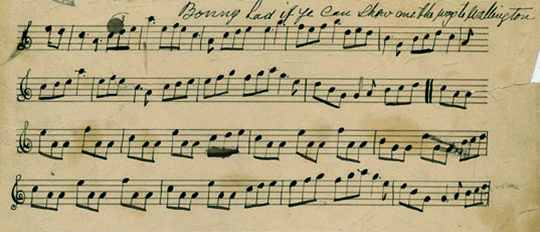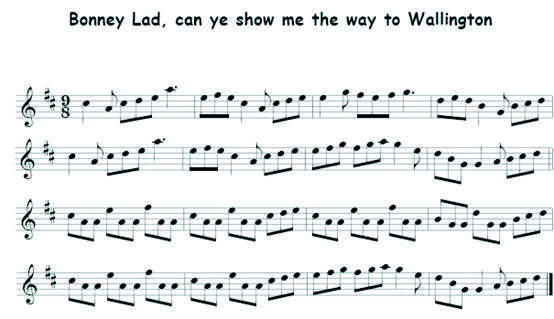The Bagpipe Society
Bonny Lad if you can shew me the way to Wallington

This odd looking tune is displayed in the FARNE archive, in the section devoted to the Henry Clough Collection, with the following note :-
“This may or may not be a version of the more common tune of a similar title; it is included as a curiosity and to see whether anyone can decipher its meaning - the ending has shades of The Rocky Road to Dublin, and while strain 2 is evidently in 9/8 strain 1 is more erratically written. Perhaps it is an interestingly wayward version, perhaps another tune entirely?” Also the following…”key signature should probably be one or two sharps; rhythms in strain 1 erratic”.
Liking a challenge, I decided to have a go, and see what I could make of it. But where was I to start? The second, (“B”), part looked like the best place, with the rhythm (9/8) well defined. Also the predominance of the note “A” indicated, to me at least, the tonic, so it was in “A” then. Playing it through on a recorder established that it really should be Mixolydian.
So, just the “A” music left then. It seemed to me that bar 8 was intact, as was bar 7, though with a possible extra dot on note 7. Working backwards, bar 6 would be fine, but for the dot on the middle crotchet. This is probably a mistake in my view. The bar fits without it. Again working further back, Bar 5 is missing its first crotchet, which seems to have been miss-placed in the previous bar. Re- drawing the bar line in the correct place, we now only have three bars to correct.
I notice that, in character with a lot of tunes, there seem to be end tags at the end of each of the preceding four bar phrases, and to keep in step with this, the bar line of bar 4 must be moved back beyond the last triplet in bar 3. Please note here that this seems to leave to many bars at the start, but as we will see, it all comes out right in the end.
Following the tags lead, which is re-enforced in the “B” music, bars 1&2 should be the same as bars 5&6. Looking at the first full bar of our tune, if the second dotted crochet is changed to a quaver, and the bar line moved forward past the dotted crotchet; the dot removed from the crotchet in bar 2, and the bar line for bar 2 moved to its appropriate place, this is what we achieve.
So bar 3 is the last to be looked at, and if the second note is again changed from dotted crotchet to quaver, seems to fit in with the rhythm of the tune well. See below for the adjusted barring of the first 4 bars of the “A” music

Overleaf is the tune I ended up with. I am not foolhardy enough to say that this is how it was played, but just how it may have been played. I have only seen two versions of this before, one in Bewick, and one in Dixon. The tune seems to have echo’s with Dixon’s first and last strains, and while the second strain of this version is absent in Bewick, the first is similar to Bewick’s last strain, though displaced by two bars (the whole tune is actually). It would seem to me that while the surviving (http://www.thesession.org/tunes/display/7394) , and currently played, tune comes from Bewick, our tune, credited in the FARNE archive as mid 19thC-mid 20thC, and written on modern, printed manuscript paper, is a survival from a time earlier than Bewick, because of the arrangement, and may represent a halfway point between Dixon and Bewick. It might even be earlier than Dixon, Dixon’s version being wrought from it, but we have now way of knowing.
There are words to a song of the same name, and these are given below.
O canny man, O shew me the way to Wallington,
I’ve got a mare to ride, and she’s a trick o’ galloping,
I have a lassie, beside, that winna give o’er her walloping,
O canny man, O shew me the way to Wallington.
Weel or sorrow betide, I’ll hae the way to Wallington
I’ve a grey mare’ o’ my ain that ne’er gives o’er her galloping,
I’ve a lass, forbye, that I canna keep frae walloping,
O canny man, O tell me the way to Wallington
Sandy, keep on the road, that’s the way to Wallington,
O’er by Bingfield Kame and the banks o’ Hallington,
Thro’ by Bavington Hh’, and in ye go to Wallington,
Whether ye gallop or trot ye’re on the road to Wallington.
Off, like the wind, he went, clattering to Wallington,
Soon he reached Binfield Kame, and passed the banks o’ Hallington,
O’er by Bavington Syke, the mare could’nt trot for galloping,
Now my dear lassie i’ll see, for I’m on my way to Wallington.

The following information came from the website Fiddlers Companion
http://www.ibiblio.org/fiddlers/FCfiles.html
The verses here appended were composed by a person of the name of Anderson, a miller at Wallington, who hunted with his landlord (Mr. Blackett) upon a certain grey mare. On rent‐days Anderson, who was a good piper, used to go with the other tenents to pay his rent‐‐but not with money. Taking the pipes under his arm, he struck up and amused the landlord and tenants with his fa- vourite tunes and songs the whole day long. The result of his piping was that he returned home with a receipt in full for his rent in his pocket, singing in triumph all the way to his little grey mare‐‐ʹShow Me the Way to Wallingtonʹʺ (Bruce & Stokoe).
From Chanter Winter 2015.
- Data Processing Notice (GDPR)
@BagpipeSociety on X (formally known as Twitter)
TheBagpipeSociety on Instagram
 BagpipeSociety on Facebook
BagpipeSociety on Facebook
Something wrong or missing from this page? Let us know!
